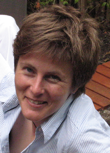Invited talk by Dr. Gabrielle Tuijthof

|
Dr. ir. Gabrielle Tuijthof Dept. of Biomechanical Engineering, Fac. of Mechanical, Materials and Maritime Engineering, Delft University of Technology, Delft, The Netherlands Dept. of Orthopaedic Surgery, Academic Medical Centre, Amsterdam, The Netherlands.
|
Technical improvement of arthroscopic and orthopaedic surgical techniques and diagnosis
Abstract: The design approach for new technical developments in orthopaedics surgery is elucidated. First, diagnosis of pathologies in small joints, e.g. the ankle joint is discussed. More specifically a CT-scan protocol using a special developed 3D foot plate is presented, which enables accurate diagnosis and surgical pre-planning. Second, the focus will be on operative techniques especially in arthroscopy. Roughly, three categories can be indicated to assist the surgeon from a technical perspective: visibility, manoeuvrability and training. For all three, examples are given of ideas, concepts, prototypes and evaluation, which highlight the importance of quantitative specific of design requirements and in depth knowledge of performance of surgical procedures. Brief Summary of Research: Minimally invasive surgical techniques in orthopaedics (arthroscopy) are highly beneficial for patients, e.g. soccer players with knee or ankle problems. However, arthroscopy is more complex and requires advanced surgical skills. In my research, surgical performance is optimized by the development innovative surgical instruments, devices, software and training facilities that enhance the visibility, manoeuvrability, accuracy and reliability of orthopaedic surgeons. This requires the combination of (experimental) research, conceptual design and management of multidisciplinary teams, which is executed in a clinically driven approach that focuses on the clinical problem. Scientifically, this implies that objective quantification of clinical problems was performed with measurements in the operating room e.g. the level of visibility during surgery. Furthermore, I have started to overcome the absence crucial technical design properties, such as the cutting force of tissues and the range of motion of the ankle joint, by measuring them. With these data, the design of innovative technical solutions was performed with that taking into account the strength and capabilities of the surgeon (the end-user of the products) and the highly dynamic environment of the hospital. The concepts were not only designed, but proof-of-principle was demonstrated with prototypes (e.g. a new irrigation shaft, a steerable cutter and a compliant drill) both technically and clinically in simulated environments. For the latter, I have developed a simulated human knee joint, which also allows surgeons to train their arthroscopic skills in an efficient and safe manner. Recently, my horizon has broadened to even less minimally invasive treatments such as image guided injections, with that keeping the focus on clinical needs and effective support of clinicians.| WebEventForm | |
|---|---|
| Title: | Technical improvement of arthroscopic and orthopaedic surgical techniques and diagnosis |
| Date: | 31 August 2011 |
| Location: | IFL, Klinikum rechts der Isar |
| Abstract: | Dr. Gabrielle Tuijthof, Assistant Professor at the Department of Biomechanical Engineering, TU Delft, will visit the CAMP chair on August 30. She will talk about technical improvement of arthroscopic and orthopaedic surgical techniques and diagnosis. |
| Imageurl: |  |
| Type: | News |
| Videourl: | |
| Conferencelink: | |
